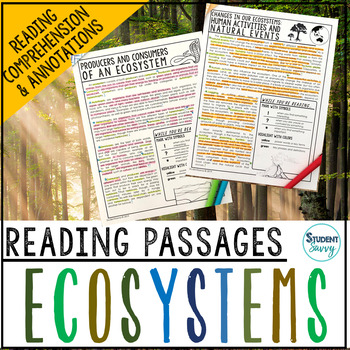Ecosystems Reading Passages - Questions - Annotations
- PDF
- Easel Activity
What educators are saying
Also included in
- Earth Science Curriculum | Environmental Science {Both DIGITAL & PRINT}NGSS (NEXT GENERATION SCIENCE STANDARDS) and COMMON CORE ALIGNED!UPDATE: OCEANOLOGY, SPACE & SOLAR SYSTEM Resources are now included!Unit topics include: Rock Cycle, Rocks & Minerals, Plate Tectonics, Ecosystems, BioPrice $298.35Original Price $331.50Save $33.15
- Ecosystems Resource Bundle**NEW UPDATE! 4/19 Now includes Reading Passages! This bundled product contains the following 7 StudentSavvy resources!Ecosystems Reading PassagesEcosystems Interactive Notebook {Digital & Print}Ecosystems Interactive PowerPoint {Google Slides Version Included}EcosystemPrice $21.58Original Price $26.97Save $5.39
- Earth Science & Environmental Science Reading Comprehension Passages, Worksheets, Questions, and Annotations Bundle!This bundle contains a total of 48 Engaging, Non-Fiction Reading Comprehension Passages with Directions for Student Annotations! Reading Comprehension Questions also included! It cPrice $40.00Original Price $51.99Save $11.99
- ALL of the Reading Comprehension Passages in the StudentSavvy Store! Nonfiction **CURRENTLY 273 Passages!**-Worksheets - Reading Comprehension Passages, Questions, and Annotations--Both Print (PDF) & Digital Options (either in Google Slides or Easel by TpT) It contains Engaging, Non-Fiction ReadPrice $195.00Original Price $302.21Save $107.21
Description
Ecosystems Worksheets - Reading Comprehension Passages, Questions, and Annotations
This resource is designed for an Ecosystems unit. It contains 5 Engaging, Non-Fiction Reading Comprehension Passages with Directions for Student Annotations! Reading Comprehension Questions also included!
Questions & Answer Keys for Each of the 5 Reading Passages!
COMMON CORE ALIGNED!
Aligned with Ecosystems Interactive Notebook (Not required to use this resource, but recommended)
Quick overview of topics covered in this resource include:
1.) The Levels of Organization and Components of an Ecosystem
-Overview of the definition of ecosystem, how it is made up of living and non-living things to help sustain life (biotic and abiotic)
-Types of biotic factors – producers, decomposers, consumers
-Abiotic factors that are important for survival (sunlight, temperature, water)
-The levels of organization within an ecosystem (ecosystem, community, population, habitat, niche, and single organism or life form) definition of each level
Keywords: biotic factors, abiotic factors, producers, consumers, decomposers, ecosystem, community, population, habitat, niche, organism
2.) The Food Chain: Moving Through the Ecosystem
-Overview of how energy (or food/nutrients) moves and flows through the ecosystem, getting passed from life form to life form.
-Describes the primary consumer (herbivores) (rabbit, goose, squirrel etc.) eats plants/autotrophs
-Description of how energy flows down to the secondary consumer (consumes the primary consumer)
-Describes how the energy flows to the Tertiary Consumer (consumes the secondary consumer) (hawk, who eats the owl, who ate the rabbit)
-Describes how energy flows to the decomposer (worms that consume the tertiary consumer / living organisms)
Keywords: food chain, primary consumer, secondary consumer, tertiary consumer, decomposer
3.) The Producers and Consumers of an Ecosystem
-Overview of what producers are (plants – can make their own food by using sunlight as energy)
-Overview of autotrophs (self-feeders/producers)
-Examples of autotrophs (algae, all green plants, bacteria)
-Overview of what consumers are (heterotrophs- unable to make their own food, consume energy)
-Types of heterotrophs in detail – omnivores, carnivores, herbivores, scavengers, and predators
Keywords: producers, consumers, autotrophs, heterotrophs
4.) Changes In Our Ecosystems: Human Activities and Natural Events
-Description of how different events such as natural occurrences or human activity can impact our ecosystems.
-Provides specific examples of each natural event (hurricane, drought, tsunami, earthquake, etc.) and how it impacts our ecosystems
-Provides specific examples of human activities (logging, hunting/poaching, irrigation, construction, pollution) and how it impacts our ecosystems
5.) Soil and the Ecosystem
-Overview of what is found in soil. How soil is essential to sustain life
-Overview of the different types of layers found in soil
-detailed description of topsoil, subsoil, parent rock, minerals, and bedrock
Keywords: soil, humus, minerals, top soil, subsoil, parent rock, minerals, bedrock
You may also enjoy:
Ecosystems Interactive Notebook
Earth Science Interactive Notebooks
Rock Cycle Interactive Notebook
Rocks, Minerals, and Gems Interactive Notebook
Plate Tectonics Interactive Notebook
__________________________________________________________________
Tips for Savvy TpT Shoppers:
How to receive credit on TpT to use for future purchases:
• Go to your My Purchases page. Under each purchase you'll see a Provide Feedback button. Simply click it and you will be taken to a page where you can give a quick rating and leave a short comment for the product. I value your feedback greatly as it helps me determine which products are most valuable for your classroom so I can create more for you.
Be the first to know about my new discounts, FREEBIES, and products:
• Look for a green star near the top of any page within my store and click it to become a follower. You will now be able to see FREEBIES and customized emails from my store!
©2019StudentSavvy
All rights reserved by author. Permission to copy for single classroom use only. Electronic distribution limited to single classroom use only. (unless you purchase the multiple license)
____________________________________________________________










